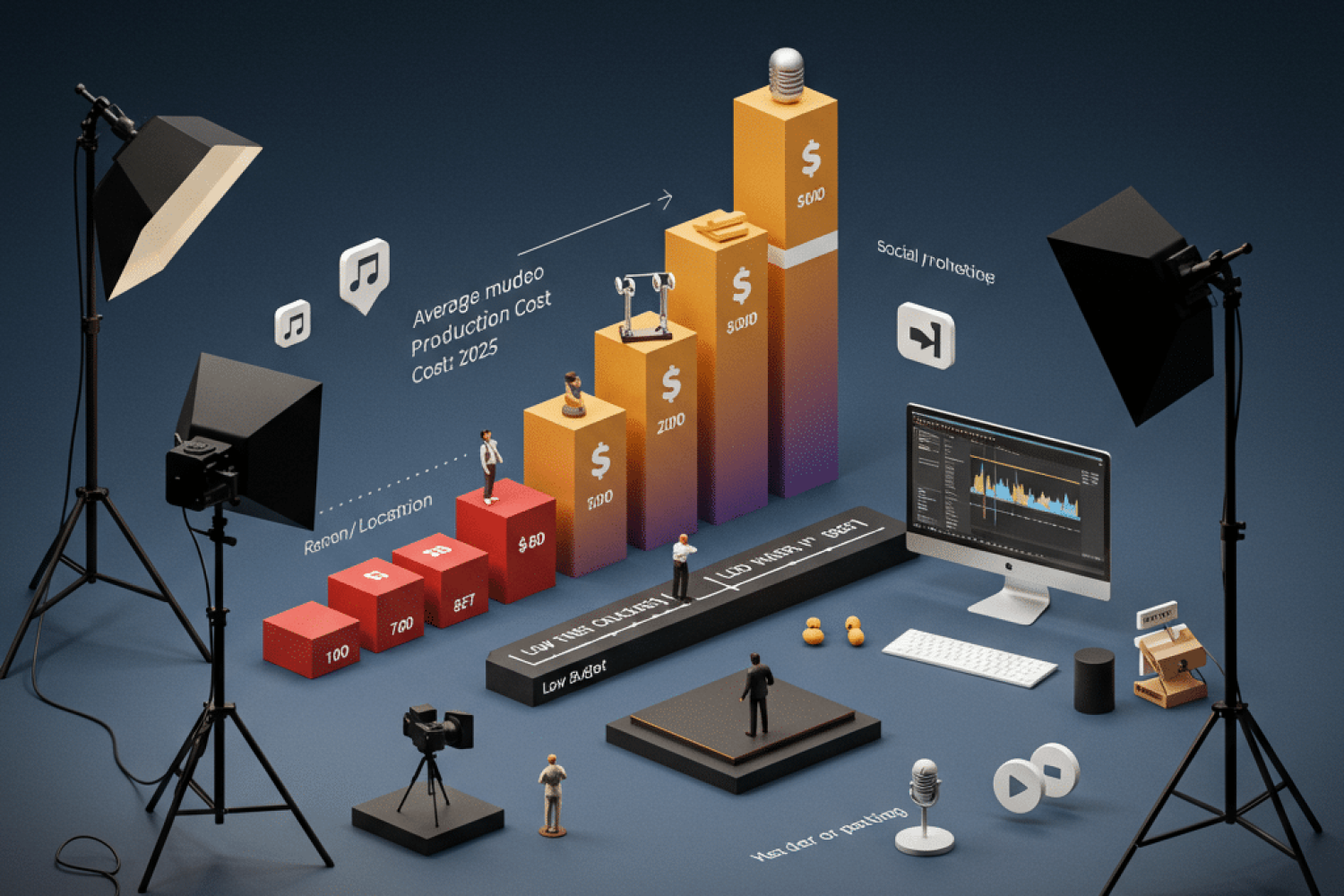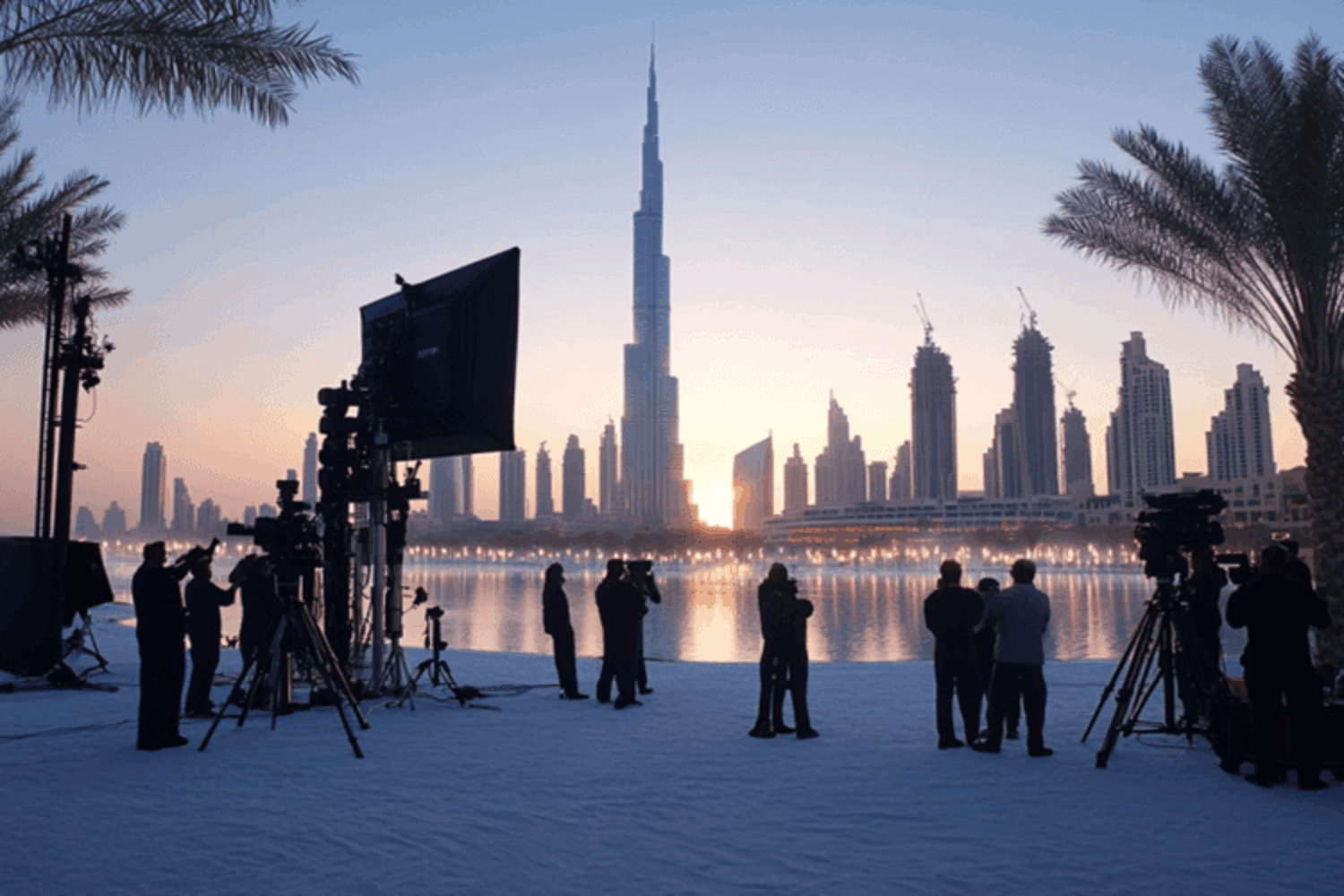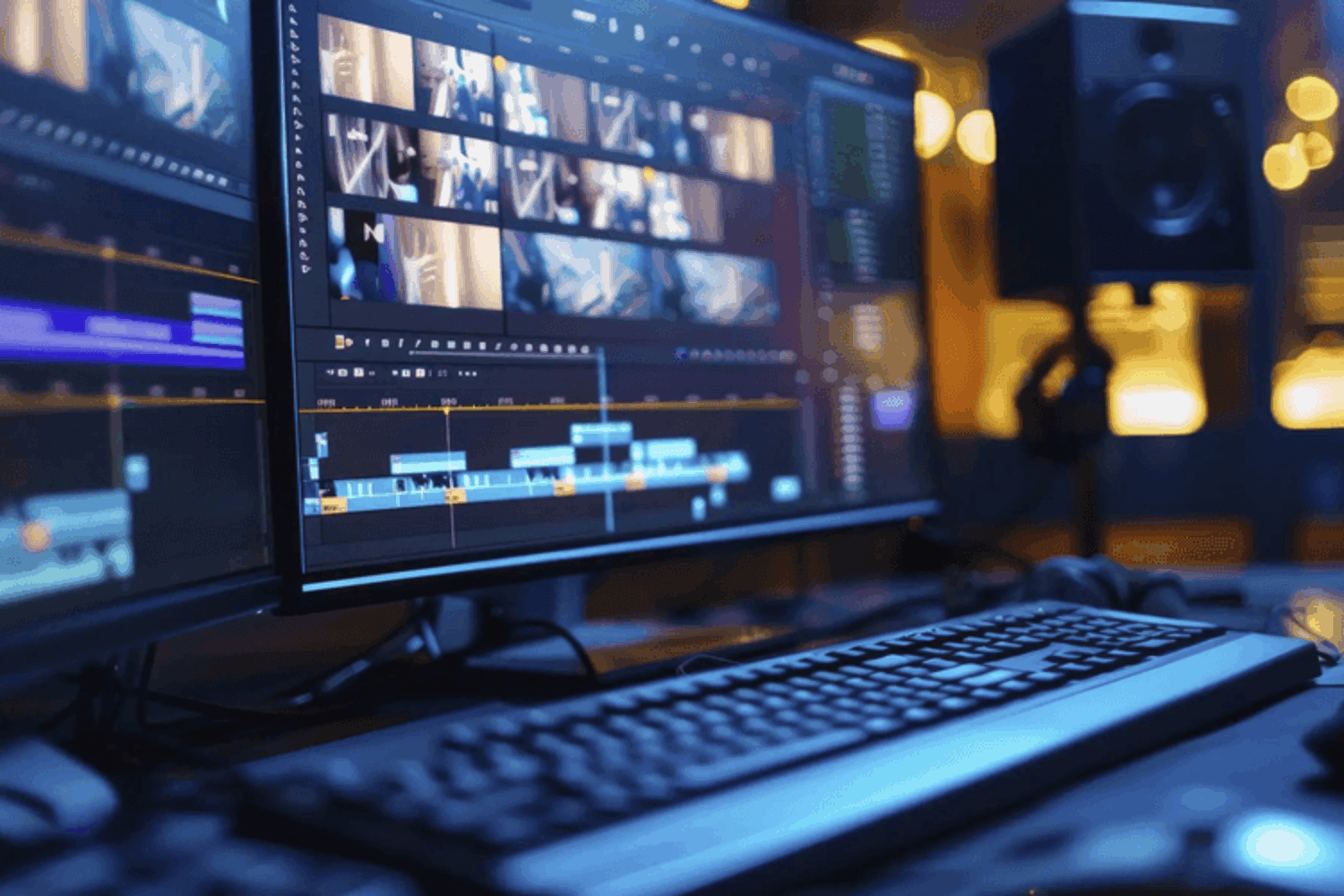Figuring out how much to spend on a music video in 2025 still gives indie and major acts headaches. In this post, we pull apart the typical budget you might expect, grade the cost brackets, point out the main drivers of those numbers, and share tips so creatives can drop jaws on-screen without planting a financial landmine.
Driving Sales in Summer:The Importance of Professional Real Estate Videos in Dubai
As the Dubai summer sun blazes, the real estate market might seem to cool down. Yet, this period offers a prime opportunity for agents and developers to heat up their sales strategies. Discover how professional real estate videos can transform passive interest into eager buyers, even in the hottest months.
Average Music Video Production Cost in 2025: Key Facts
In today’s music industry, a music video isn’t just a visual accompaniment to a song—it’s a brand statement, a storytelling device, and a vital component of an artist’s digital presence. With platforms like YouTube, TikTok, and Instagram making music videos more discoverable than ever, their role in shaping an artist’s image and success has never been more important.
As we step into 2025, artists and labels alike are asking one important question: How much does it cost to produce a music video now?
This guide explores the real costs of music video production in 2025, with a full breakdown of pricing, production phases, money-saving tips, and expert insights to help you budget smart—whether you’re a bedroom musician or a chart-topping star.
💵 What’s the Average Cost of a Music Video in 2025?
The cost of producing a music video in 2025 can range from as little as $1,000 to well over $500,000, depending on the scope, quality, and complexity of the project.
Here’s a breakdown of the typical pricing tiers:
Low-Budget (DIY/Indie): $1,000–$10,000
Mid-Tier (Professional Indie/Independent Label): $10,000–$50,000
High-End (Major Label/Commercial Quality): $50,000–$500,000+
While these figures have always varied, there are a few reasons why costs have changed in 2025:
Inflation has affected location rentals, labor costs, and equipment pricing.
New technologies like AI-driven editing, virtual production, and LED-wall studios have both increased quality and opened cost-saving alternatives.
Distribution platforms now demand not just one music video, but teaser reels, behind-the-scenes content, and viral clips—driving up content needs and thus production budgets.
🎥 What Goes Into a Music Video Budget?
Music video production is typically divided into three main phases: pre-production, production, and post-production. Each phase has its own costs and specialists involved.
1. Pre-Production Costs
This is the planning phase and sets the tone for the entire project. It includes concept development, storyboarding, casting, and securing locations.
Creative Direction: Hiring a director or creative lead can cost between $1,000 and $10,000, depending on their experience and the complexity of the concept.
Scripting & Storyboarding: A solid script and visual plan can cost $500–$3,000.
Casting Talent: Professional actors or dancers may cost $250–$1,000 per person per day. Well-known influencers or actors may charge significantly more.
Location Scouting and Fees: Renting a professional studio or exotic location can range from $1,000 to $10,000 per day. Public spaces might require permits.
Pre-production is the most crucial planning phase—it defines the creative direction and ensures efficiency on shoot days.
2. Production Costs
This is the shooting phase, where most of the budget is spent. The quality of your camera, crew, lighting, and setup will significantly influence the end product.
Camera & Equipment Rental: From a basic DSLR to an ARRI Alexa Mini, equipment rental can range from $1,000 to $10,000 per day.
Crew Costs:
Director: $2,000–$10,000/day
Cinematographer (DP): $1,500–$5,000/day
Gaffer/Lighting Tech: $800–$2,000/day
Production Assistants: $300–$500/day
Set Design and Props: Depending on your vision, custom-built sets can cost $5,000 to $50,000 or more.
Wardrobe & Makeup: Stylists and makeup artists can cost $1,000 to $5,000 per shoot. High-fashion looks can dramatically increase this.
Production days are expensive. Any delays can quickly raise costs, making preparation and scheduling critical to staying within budget.
3. Post-Production Costs
After filming wraps, the footage moves into the editing phase—where the raw visuals are shaped into a compelling final product. This stage adds polish, mood, and visual identity to the video through editing, color grading, sound design, and visual effects. Many artists choose to work with a post production company to ensure high-quality results, as these professionals bring the technical expertise and creative finesse needed to make a music video truly stand out. Whether you’re adding cinematic color tones or integrating VFX, a skilled post production team is essential to achieving a polished, professional look.
Editing: A good editor will charge $1,000–$5,000 depending on the complexity, number of revisions, and turnaround time.
Color Grading: Vital for mood and cinematic quality—typically $800 to $3,000.
Visual Effects (VFX): Ranges from basic motion graphics ($1,000) to complex 3D rendering and CGI ($50,000–$100,000+).
Sound Design: If needed, custom sound work can cost $500–$3,000.
Motion Graphics/Title Animation: For lyric videos or branded elements, expect to spend $500 to $10,000.
4. Additional/Hidden Costs
Insurance: Most productions require liability insurance, costing $500–$2,000 per day.
Catering & Transportation: Feeding and transporting your crew adds up—around $20–$50 per person for meals.
Marketing & Distribution: Many artists now allocate 10–30% of their video budget for YouTube ads, TikTok influencers, and social campaigns.
📊 Real-World Budget Examples
Let’s look at realistic examples of music video budgets across different levels:
🎧 Indie Video ($3,000 Budget)
Shot on a mirrorless camera by a student crew
One public location
Self-edited using free software
Minimal wardrobe and lighting
Result: Great for releasing singles on YouTube, TikTok, or Spotify Canvas. Budget-conscious but creatively satisfying.
🎙️ Mid-Tier Video ($25,000 Budget)
2-day shoot with a small professional crew
Rented location and high-end DSLR
Pro editing, color grading, basic VFX
Multiple looks, stylists, and post-roll teaser edits
Result: Ideal for indie labels and artists with a growing audience who want to stand out visually.
💎 Major Label Video ($150,000+ Budget)
Celebrity director and high-end RED/ARRI camera
Custom-built set and wardrobe
Dozens of extras, dancers, multi-day shoot
Advanced CGI and SFX, multi-version edits for platforms
Result: Music video as a cinematic masterpiece—great for award shows, YouTube trending, and press coverage.
💡 Cost-Saving Tips for Artists in 2025
If you’re working with limited resources, here are a few ways to stretch your dollars:
Use AI Tools: RunwayML and Pika offer background removal, motion tracking, and AI-generated B-roll to reduce VFX and post costs.
Shoot During Golden Hours: Save on lighting by using early morning or sunset light.
Work With Film Schools: Students are often eager to collaborate for portfolio work at reduced rates.
Plan for Multi-Purpose Content: Capture social teasers, vertical clips, and behind-the-scenes footage during the shoot to maximize ROI.
Consider Virtual Production: LED volume studios offer immersive environments without expensive travel.
🔮 Looking Ahead: Trends Shaping Music Video Costs
Here are some 2025 trends that are shaping where music video budgets go:
1. Virtual Production
LED-wall stages allow creators to shoot in virtual environments. No travel, no set building—just immersive backgrounds that can cost $15,000–$30,000 per day.
2. AI-Powered Post-Production
AI is automating many editing and effects tasks, which can cut post-production time and cost by up to 50%.
3. Augmented Reality & Interactivity
AR-enhanced music videos and 360° experiences are gaining traction but come at a premium, often adding $10,000–$100,000 to a budget.
4. Global Collaboration
Cloud-based tools allow artists to work with directors, editors, and VFX artists from around the world—often at lower regional rates.
🧠 Final Thoughts: Make Every Dollar Count
Music video production in 2025 offers more creative freedom than ever—but also requires smarter planning and budgeting. Whether you’re producing a $3,000 indie video or a $300,000 studio-backed production, the key to success is knowing what you’re paying for and how each decision supports your creative goals.
Remember: a well-executed, visually compelling video doesn’t have to be expensive. It has to be authentic and purposeful. Focus on the story, surround yourself with capable creatives, and leverage modern tools to bring your vision to life—no matter the budget.
Video Production and Editing Costs Per Finished Minute: A Comprehensive Breakdown
In today’s digital landscape, video content is a pivotal tool for businesses aiming to engage audiences, enhance brand visibility, and convey messages effectively. Whether you’re a startup, an established enterprise, or an individual content creator, understanding the costs associated with video production and editing is crucial for budgeting and planning. This guide delves into the various factors influencing video production costs, providing a detailed breakdown to help you navigate the financial aspects of creating compelling video content.
What Is “Cost Per Finished Minute”?
The term “cost per finished minute” refers to the total expenditure required to produce one minute of final, polished video content. This metric encompasses all stages of video creation, including pre-production, production, and post-production. Understanding this cost is vital for businesses and creators to allocate resources appropriately and set realistic budgets.
Factors Influencing Video Production Costs
Several elements contribute to the overall cost of video production:
- Video Type: The style and complexity of the video—be it live-action, animation, or a mix—significantly impact costs. For instance, 2D animated videos can range from $4,000 to $25,000 per minute, while 3D animations may cost between $12,000 and $80,000 per minute.
- Production Quality: High-definition visuals, professional-grade equipment, and experienced crews elevate production value but also increase expenses.
- Project Complexity: Videos requiring intricate scripts, multiple locations, special effects, or celebrity talent naturally incur higher costs.
- Turnaround Time: Tight deadlines may necessitate additional resources or expedited processes, leading to increased costs.
Pre-Production Costs
Pre-production is the planning phase, setting the foundation for the entire project. Typical expenses include:
- Concept Development: Crafting the video’s core idea and objectives.
- Scriptwriting: Developing a detailed script to guide the production.
- Storyboarding: Visualizing scenes to plan shots and sequences.
- Casting: Hiring actors or voiceover artists.
- Location Scouting and Permits: Identifying and securing filming locations.
- Project Management: Coordinating schedules, budgets, and logistics.
Estimated costs for pre-production can range from $500 to $2,000, depending on the project’s scale and requirements.
Production Costs
The production phase involves capturing the actual footage and is often the most resource-intensive. Key cost components include:
- Crew: Directors, cinematographers, sound technicians, and assistants.
- Equipment: Cameras, lighting, sound gear, and other technical equipment.
- Talent: Fees for actors, presenters, or voiceover artists.
- Location and Studio Rentals: Costs for shooting locations and studio spaces.
- Travel and Logistics: Expenses related to transportation, accommodation, and catering.
Production costs can vary widely:
- Low-End Productions: $500 to $1,000 per finished minute.
- Mid-Range Productions: $1,000 to $3,000 per finished minute.
- High-End Productions: $3,000 to $10,000 or more per finished minute.
Post-Production Costs
Post-production is where the raw footage is transformed into the final product. This stage includes:
- Editing: Assembling and refining the footage.
- Color Grading: Adjusting colors to enhance visual appeal.
- Sound Design: Adding sound effects, background scores, and voiceovers.
- Visual Effects (VFX): Incorporating special effects to enhance the video.
- Motion Graphics: Creating animated elements or graphics.
Post-production costs can range from $300 to $2,000 per finished minute, influenced by the complexity of the work involved.
Optional Add-Ons and Additional Costs
Certain features can add value to your video but also increase costs:
- Subtitles and Translations: Making content accessible to a broader audience.
- Multiple Versions: Creating different formats or versions for various platforms.
- Marketing and Distribution: Costs associated with promoting and distributing the video.
These additional services can add $50 to $500 or more per finished minute, depending on the scope and requirements.
Industry Examples and Cost Ranges
Understanding cost variations across different video types can aid in budgeting:
- Corporate Videos: Typically range from $1,000 to $20,000 per finished minute, depending on complexity.
- Commercials: Can cost between $2,500 and $50,000 per finished minute, influenced by factors like talent and special effects.
- Documentaries: Vary from $2,000 to $25,000 per finished minute, based on production scale and travel requirements.
- Animated Videos: Costs range from $1,000 to $45,000 per finished minute, depending on animation style and complexity.
Estimating Your Own Video Project
To estimate the cost of your video project:
- Define Your Objectives: Understand the purpose and target audience of your video.
- Choose the Video Type: Decide on the style (live-action, animation, etc.).
- Determine the Length: Establish the desired duration of the video.
- Assess Complexity: Consider factors like special effects, talent, and locations.
- Set a Budget: Allocate funds based on the above factors and seek quotes from professionals.
Utilizing online calculators or consulting with production companies can provide more accurate estimates.
Tips to Control and Optimize Costs
Managing video production expenses is essential for staying within budget:
- Plan Thoroughly: Detailed planning can prevent costly revisions and delays.
- Repurpose Content: Use footage across multiple platforms to maximize ROI.
- Choose the Right Talent: Select professionals whose expertise aligns with your project needs.
- Negotiate Rates: Discuss pricing with vendors and seek competitive quotes.
- Utilize Technology: Leverage software and tools that streamline production processes.
Conclusion
Understanding the costs associated with video production and editing is vital for effective budgeting and project planning. By considering factors like video type, production quality, and complexity, you can estimate expenses and make informed decisions. Remember, investing in quality video content can yield significant returns, enhancing brand visibility and audience engagement.
How Much Does It Cost to Create an Animated Series?
Introduction:
Dubai’s emergence as a regional creative powerhouse is no accident. With its advanced media infrastructure, a surge of government incentives, and a diverse talent pool, Dubai is fast becoming the go-to destination for animation production in the Middle East. Whether you are a local entrepreneur, a regional broadcaster, or an international content creator eyeing the MENA market, understanding the financial landscape of producing an animated series in Dubai is crucial.
Animation production costs can seem opaque without transparency on local market standards. This guide will walk you through the essential cost components, current price ranges, and the key factors influencing your budget in 2025 — all grounded in the realities of Dubai’s media ecosystem.
Understanding the Animation Production Process in Dubai
Animation is a multifaceted process that spans creative, technical, and logistical stages. From concept to final cut, your budget needs to cover:
- Pre-Production: Concept development, scripting, storyboarding, character design, and voice casting.
- Production: The animation itself—whether 2D, 3D, or hybrid styles—plus background design and sound recording.
- Post-Production: Editing, compositing, sound mixing, and visual effects.
Each stage involves specialized professionals whose fees can vary based on expertise and the studio’s reputation.
Key Cost Drivers for Animated Series in Dubai
1. Animation Style and Complexity
The style you choose sets the baseline for your budget.
- 2D Animation:
Dubai studios offer competitive rates for 2D animation, which remains the most cost-effective approach. This style fits diverse genres, from educational series to children’s cartoons. Expect to pay between AED 18,000 to AED 70,000 per finished minute for quality 2D work from mid-tier studios. Highly detailed or frame-by-frame animation can push prices upward. - 3D Animation:
For productions requiring lifelike characters, immersive environments, or cinematic visuals, 3D animation is the industry standard. Dubai’s 3D animation costs range from AED 70,000 to over AED 350,000 per finished minute. This reflects the advanced technology and technical expertise needed. - Stop-Motion & Experimental Styles:
Less common in Dubai, stop-motion animation is labor-intensive and costly, often exceeding AED 100,000 per minute. Experimental or mixed media projects may require bespoke pricing. - Motion Graphics:
Simpler and often used for corporate storytelling or marketing, motion graphics cost AED 7,000 to AED 30,000 per finished minute.
2. Episode Duration and Volume
Longer episodes naturally cost more due to additional animation frames, voice-over time, and post-production work. For instance:
- A 5-minute web episode might cost around AED 90,000 – AED 350,000 for 2D animation.
- A 22-minute TV-standard episode can exceed AED 1.5 million, depending on complexity.
Bulk orders, such as a 10 or 20 episode season, might benefit from volume discounts or retainer agreements with studios.
3. Creative and Technical Quality
Dubai’s growing animation studios offer a range of quality tiers:
- Entry-level Studios: Ideal for startups or low-budget projects, these studios offer basic animation and voice work at lower prices but may lack experience with large-scale productions.
- Mid-Tier Studios: Balance quality and cost, suitable for most commercial projects.
- Premium Studios: Known for award-winning work and international clientele, expect to pay premium rates for high-end 2D/3D series.
Detailed Cost Components Breakdown for Dubai Animated Series
Pre-Production (AED)
| Component | Typical Cost Range | Notes |
|---|---|---|
| Scriptwriting | 3,500 – 15,000 per episode | Depends on writer experience and episode length |
| Storyboarding | 1,500 – 7,000 per episode | Visualization of scenes for director and animators |
| Character Design | 1,500 – 15,000 per character | Detailed designs increase costs |
| Voice Casting & Recording | 1,500 – 15,000 per actor | Language, accent, and actor experience matter |
Production (AED)
| Component | Cost Range per Finished Minute | Notes |
|---|---|---|
| 2D Animation | 18,000 – 70,000 | Mid-tier quality in Dubai |
| 3D Animation | 70,000 – 350,000 | Higher complexity and rendering times |
| Background & Layout | 1,500 – 8,000 | Detail and number of unique backgrounds |
| Sound Design & Music | 3,000 – 15,000 | Custom scores add value |
Post-Production (AED)
| Component | Cost Range per Episode | Notes |
|---|---|---|
| Editing & Compositing | 3,000 – 15,000 | Final polish and corrections |
| Visual Effects (VFX) | 7,000 – 30,000 | Special effects added if needed |
Real-World Example: Budgeting a 10-Episode Mid-Range 2D Animated Series in Dubai
Suppose you want to produce a 10-episode children’s series, each episode lasting 10 minutes, using quality 2D animation:
| Cost Element | Estimated Cost (AED) | Comments |
|---|---|---|
| Animation (10 episodes × 10 min × AED 35,000/min) | 3,500,000 | Mid-range animation pricing |
| Pre-Production (script, storyboard, voice talent) | 300,000 | Includes 3 writers, multiple voice actors |
| Post-Production (editing, sound design, VFX) | 300,000 | Final polishing and sound mixing |
| Total Estimated Budget | 4,100,000 AED | Equivalent to approx. $1.12M USD |
Why Producing in Dubai Makes Financial and Strategic Sense
Access to Government Incentives and Media Free Zones
Dubai offers several media free zones like Dubai Media City and Dubai Studio City. These zones provide streamlined business setup, tax advantages, and access to professional networks, reducing administrative overhead.
Multicultural Talent Pool and Bilingual Capabilities
Dubai’s diversity means you can find voice talent and animators fluent in Arabic, English, Hindi, and more — critical for regional content localization and international distribution.
Proximity to Growing Regional Markets
Producing in Dubai gives you a gateway to the MENA region, where demand for locally relevant animated content is rapidly rising. Regional broadcasters and streaming platforms are actively investing in animation, increasing opportunities for content creators.
Tips for Managing Your Animated Series Budget in Dubai
1. Start with Clear Creative Goals
Detailed scripts and storyboards prevent costly revisions. Define your animation style early and communicate expectations clearly.
2. Leverage Local Studios with Proven Track Records
Research and select studios with relevant portfolio work. Trusted studios reduce risks of delays and subpar quality.
3. Consider Mixed Animation Approaches
Sometimes combining 2D with motion graphics or limited 3D can reduce costs without sacrificing quality.
4. Plan Voice Recording Efficiently
Batch voice recording sessions to optimize time and costs, and consider remote recording options to access wider talent.
5. Use Stock Elements When Possible
Stock sound effects, music, and reusable backgrounds can cut costs significantly.
Final Thoughts:
Producing an animated series in Dubai involves navigating a diverse market with varying price points. Costs are influenced by creative ambition, technical complexity, and local market conditions. While budgets range widely, a mid-tier 2D series typically costs between AED 3 million to AED 5 million for a full season of 10 episodes.
Establishing clear contracts, protecting intellectual property rights, and working with reputable professionals ensure your investment is secure and your creative vision realized.







